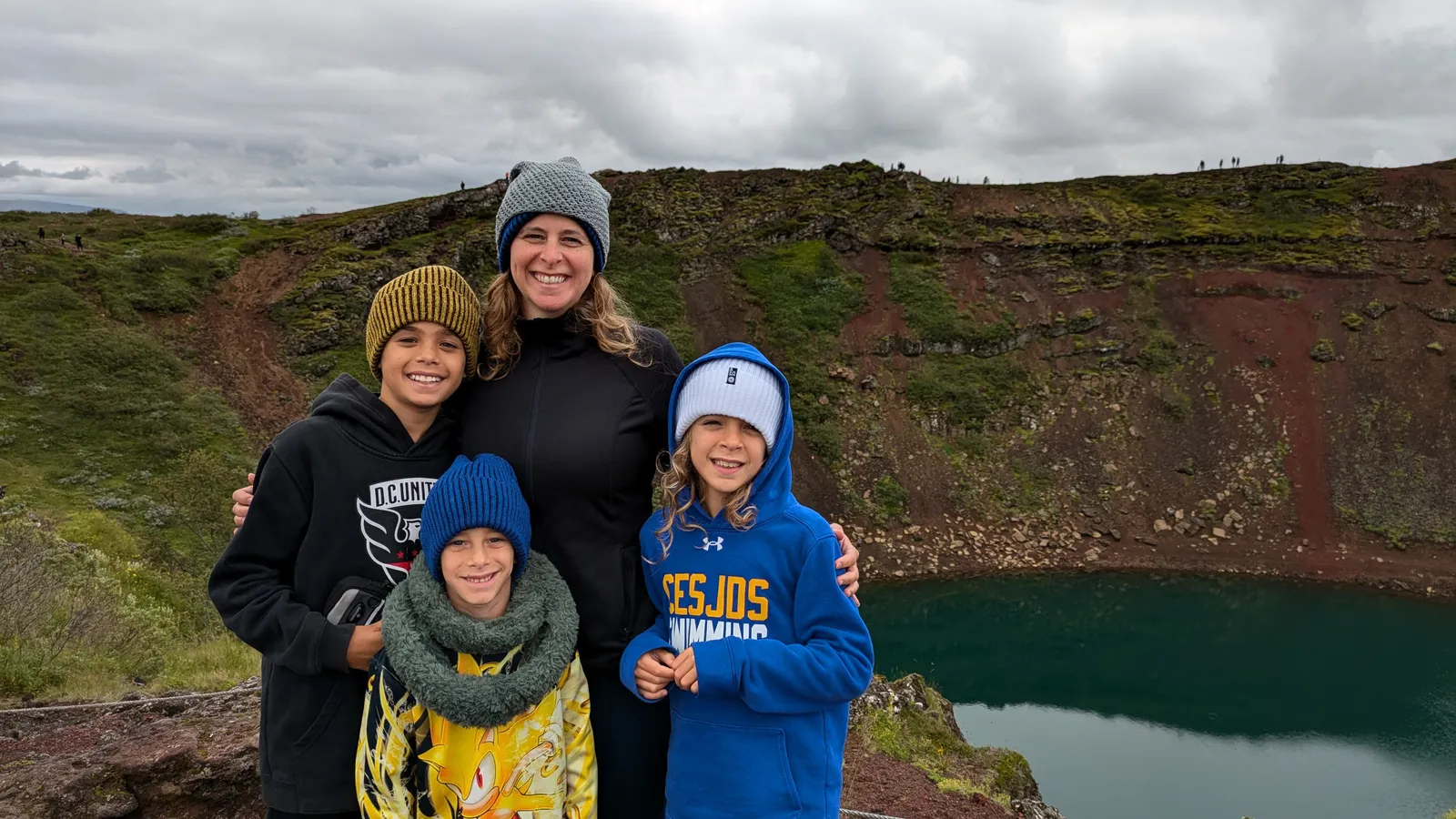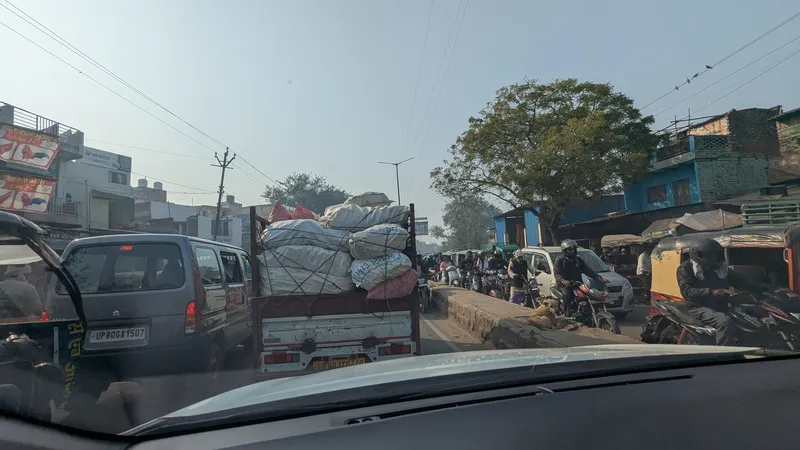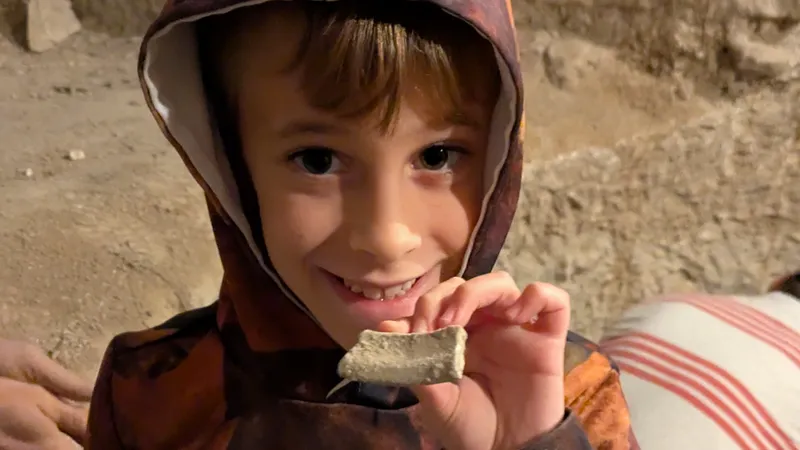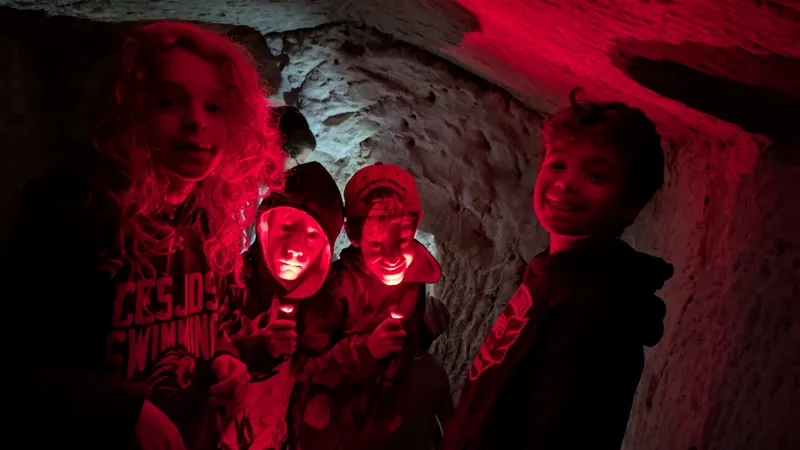Reflections regarding Tuesday July 30, 2024 in Reykjavík, Iceland
Our local morning bus driver was friendly and helpful, letting us know what stop to get off, the next bus to catch, and reminding me repeatedly to sit down. We made it to the BSI Terminal where our tour guide was scheduled to pick us up. The boys were really patient while waiting. At some point I realized I had forgotten the handwarmers, again. At least the sun was shining, and we were all wearing lots of layers. In fact, I don’t think we ever changed. We just kept adding layers while in Reykjavik because we elected not to take any jackets with us due to space constraints. My hat did not come off for three days.
Once on the tour bus the day improved, though we really missed having Chaim and Shai with us. Our tour guide was excellent and very knowledgeable. In addition to taking us to the scheduled stops he added a few based-on people’s interests. One of our fellow passengers was eager to learn about energy so our first stop was a geothermal plant. It was fascinating. All over Iceland are natural hot springs running underground warmed by magma deeper underground. In 2018 someone really smart figured out how to drill down into the ground and lay pipes that can withstand thousands of degrees of hot water. This water is then pumped to people’s homes as their hot water and geothermal energy supplies.
Outside the plant we walked onto the volcanic fields with young moss growing all over. The boys had a field day (pun intended) jumping and running on the moss, which they described as squishy and fun to bounce on. It was as if they were running around at a trampoline park back home. Inside the facility, the boys looked around while I tried listening to the guide talk about Iceland’s natural geothermal energy and how the plant and individual homes tap into it to heat homes and water. According to our tour guide, and not at all fact checked by me, Iceland’s law states that anyone who purchases land with a hot spring on the land owns that hot spring and does not need to pay for the heating. And it’s only $50/month for those whose heat is supplied by the geothermal plant. Having lived in Boston and Chicago during some very cold winters that sounded to good to be true.
After our visit to the Geothermal plant, our tour guide took us to a small mall to use the toilets since our next stop wouldn’t have one. I took mercy on my children and bought them each a hat. Or maybe it was because I was so cold and missing my handwarmers. Proud of myself for thinking about my children’s needs, I took the hat I had bought for Shai who was back home and wore it under my own hat. Then we made our way to Kerið (pronounced k-air-ith) Volcanic Crater. Kerið is relatively young compared to the other volcanic craters (also called calderas) in the area. The ground is a deep red and looks kind of like someone took thousands of gigantic chili pepper spice bottles and poured them all over. The center of the crater is a lake with beautiful cerulean water bordered by volcanic rocks, colorful wildflowers, and shrubs; fish and plant life thrive there. The entire area feels like it was lifted straight from fantasy land. I could have spent all day there.
After Kerið our tour guide took us to another unscheduled stop where we had the opportunity to see how Icelanders built their homes and churches from rock and turf. These homes were built knowing that they would need to be rebuilt every 20 years. The house, which was really an old church, was black because the available rocks are black. But, the roof! The roof was something else. The roof was made of turf, meaning there is a wooden frame that is then covered with grass and soil. This particular roof looked like an extreme version of a roof top garden with moss, shrubs, and flowers growing out of it. It was so cool. The inside walls and floor of the church were made of wood, pristinely kept. Inside were an organ that couldn’t be played, a box of stacked bibles, a floor to ceiling sculpture of a cross with Jesus nailed to it, and candle holders were made of iron, which the Vikings were able to melt using the heat from hot springs that we were told can get as hot as 6000°F. We learned that this is also why the Vikings had better tools and weapons back in the day. Monastic music played nonstop, giving the church an ethereal feel. Matanel was deeply concerned about the man with nails in him when he noticed the sculpture of Jesus nailed to the cross. I explained and he was able to move on. The entire space could not have been more than 20-feet long and 10 -feet wide.
After exploring the grounds and an old tunnel leading under the new church, we headed to Gullfoss Falls. These falls are extraordinary. The power of the water crashing down over the falls is immense. The sound, tremendous. My dreams of being a whitewater river expert were stirring awake, although no one in their right mind would kayak this waterfall. (Okay, after writing that last sentence I googled “kayak over Gullfoss Waterfall” and it turns out that there are three insane kayakers who successfully kayaked over the falls, TWICE and in the SNOW!”) At the waterfall, you look northeast and see a giant river rushing toward the falls. Then, you look to the southeast where the water creates a smaller river snaking its way through a canyon with volcanic rock on either side. On a great day the rushing water is a piercing blue. On a bad day, it’s brown. We were lucky because it had just rained, cleaning out some of the muck that can get into the river. The water was somewhere between green and blue.
Even though we were cold, we walked right into the massive spray of the falls to get the best views. We got wet, but our new hats kept us warm! We then walked to the edge of the cliffs where there was an easy 200ft drop on the other side. Only after I had gone to bed that night did I start freaking out about the fact that my children were at the edge of a cliff without a railing. Not sure how thinking about it after the fact was going to do anything, but that’s when the sheer magnitude of the moment hit me. The two thoughts that went through my head were “What the hell did I just allow my children to do?” and “Yep. I’ll probably do something like that again and freak out about it after the fact, again.”
Next up was The Great Geysir, a geiser that blows up every five to ten minutes and is surrounded by boiling mud and smaller hotsprings. By this point, Amichai was exhausted and did not want to walk anymore. Eventually, we all made our way to the observation point to watch Geysir do its thing. It took three explosions for us to get the timing right for a full video. Another amazing moment. We decided it looked like the ground was puking upward.
Our last stop was Thingvellir National Park. This is where the first parliament met in 930CE until 1271CE. It sits between the North American and Eurasian continental plates and you can see the continental drift when standing at an upper part of the park. The entire landscape is made because of the plate tectonics that occur here. The hike was a fifteen minute hike up to a waterfall, a fifteen minute hike back the way we came to take another fifteen minute hike up to an observation point. We had one tiny challenge; Matanel had fallen asleep. No worries! Matanel weighs about as much as a feather, or about all four of the kids’ backpacks together minus a few pounds. I started to carry him out of the bus when the tour guide asked me if I’d be okay. I said yes confidently, while silently wondering if I would be. Off we went. Just kidding. First we had to go to the toilets, again. In total, I managed to hold Matanel for ten minutes while waiting for Amichai and Eitan to finish their business and then carry him to the waterfall and back down before he was awake enough to start walking. Not going to lie. I’m feeling very proud of myself.
Every part of the park was gorgeous. As we hiked and explored, I could not imagine a more tranquil, awe-inspiring, spiritual, or magical place. Makes me wonder if peace talks should always be held in a place like this. A place between places where we can almost see the earth moving at its own glacial pace, and we are reminded that people are temporary.
On the way back home, the boys came up with a list of awards, as if we were giving out paper plate awards to the different stops. Truthfully, the discussion that ensued was highly informed and educational even if their ultimate awards do not capture that. Here is what they decided:
- “Biggest and Funnest” Award: The Moss Fields
- “Prettiest and Slipperiest” Award: Kerið Volcanic Crater
- “Smelliest, Smokiest, Hottest, and Most Explosive” Award: Geyser
- “Coolest, Most Dangerous, and Mistiest” Award: Gullfoss Waterfall
- “Best View and Tallest” Award: The Ridge at Thingvellir National Park
One day, I hope to be able to return with the whole family so that Shai and Chaim can experience these natural wonders with their own eyes.



